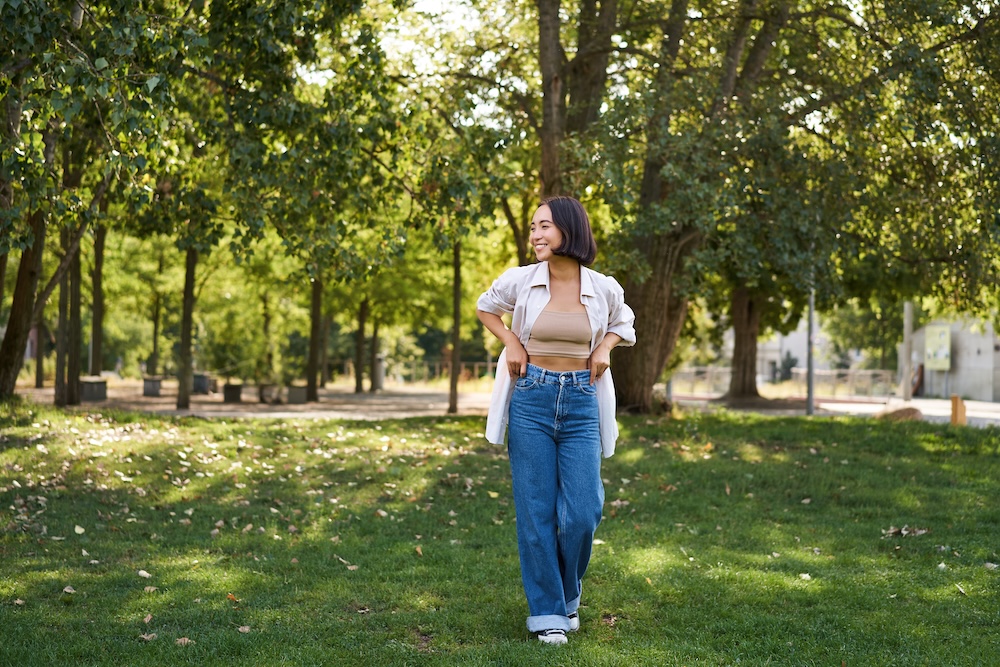Baggy jeans and supersized blazers are dominating street style and runways alike. Relaxed but polished, this pairing balances comfort with statement dressing, making it easy to style up or down. But as trends cycle faster than ever, the bigger question is: how do we embrace what’s fresh without fueling throwaway culture?
With fashion’s environmental impact under growing scrutiny, the key is to enjoy trends while practicing circular fashion — reusing, thrifting, swapping, and investing in pieces built to last. Here’s how to wear the look while keeping sustainability at the forefront.
Baggy Jeans: Style Meets Longevity
Baggy jeans have been a staple in different decades, from 1990s skater style to early 2000s casual wear. Today’s version leans looser, often high-waisted, and pairs effortlessly with fitted tops or oversized layers.
Sustainable tips for baggy jeans:
- Thrift first: Denim is durable and widely available second-hand. Vintage or thrifted jeans often outlast fast fashion alternatives.
- Rework old denim: Turn wide-leg or straight jeans into a baggier fit with simple tailoring, or distress/re-dye older pairs for a new look.
- Choose circular brands: Look for denim companies that run take-back programs (like Levi’s SecondHand or brands that recycle old denim into new fibers).
Supersized Blazers: Oversized but Intentional
The oversized blazer trend is about power, polish, and volume. When styled right, it feels structured without stiffness — and can be surprisingly versatile.
Sustainable tips for blazers:
- Shop vintage: Thrift stores and consignment shops are full of quality blazers at a fraction of the cost and footprint.
- Borrow or swap: Oversized fits are forgiving — swap with a friend, or shop clothing swaps to refresh your look without new production.
- Buy quality, not quantity: A well-made blazer can last decades. Tailor it slightly for balance rather than replacing it when styles shift.
How to Combine Baggy Jeans and Supersized Blazers Sustainably
The appeal of this pairing is its balance — loose denim with structured outerwear. To make it eco-friendly:
- Pair thrifted baggy jeans with a borrowed or vintage blazer.
- Repurpose what you already own — belting a larger men’s blazer instantly gives it a trendy oversized fit.
- Mix-and-match: Instead of buying three variations, use one core piece styled different ways.
Outfit ideas:
- Baggy jeans, vintage band tee, and an oversized plaid blazer.
- Cropped baggy jeans, fitted turtleneck, and a second-hand black blazer.
- Thrifted straight-leg jeans, graphic tee, and a camel blazer sourced from a clothing swap.
Spring Fashion Forecast: Maxed-Out Hems, Sheer Layers, and More
This season’s broader trends — from maxed-out hems to sheer layering — also offer opportunities to reimagine fashion circularly.
- Maxed-out hems: Look for pre-loved maxi skirts or wide-leg trousers. Hem adjustments and tailoring can transform pieces.
- Sheer fabrics: Layer vintage sheer blouses over tanks, or borrow from resale platforms.
- Bubble hems and drop-waists: Instead of buying new, revive early 2000s thrift pieces where these silhouettes originally lived.
The key is resisting fast-fashion versions of these looks and instead leaning into circular economy practices that give garments a second, third, or even fourth life.
Rethinking Throwaway Culture
Fast fashion thrives on impulse trends — buy now, toss later. But the ripple effects are enormous: textile waste, landfill overflows, toxic dyes, and emissions from constant production. Trends like baggy jeans and blazers don’t need to become part of that cycle.
By choosing swap over shop, thrift over throwaway, repair over replace, you not only wear the season’s best looks but also take part in reshaping the culture of fashion itself.
Final Thoughts
Baggy jeans and supersized blazers prove that style can be bold and effortless at the same time. But the bigger win comes when we style these trends through sustainable choices: reworking old denim, shopping thrift, swapping blazers, and pushing back against fast fashion’s disposability.
Every choice you make — whether it’s rescuing denim from a thrift rack or swapping blazers with a friend — creates ripples. These small shifts collectively move fashion from throwaway culture toward a circular, sustainable future.









Reader Interactions